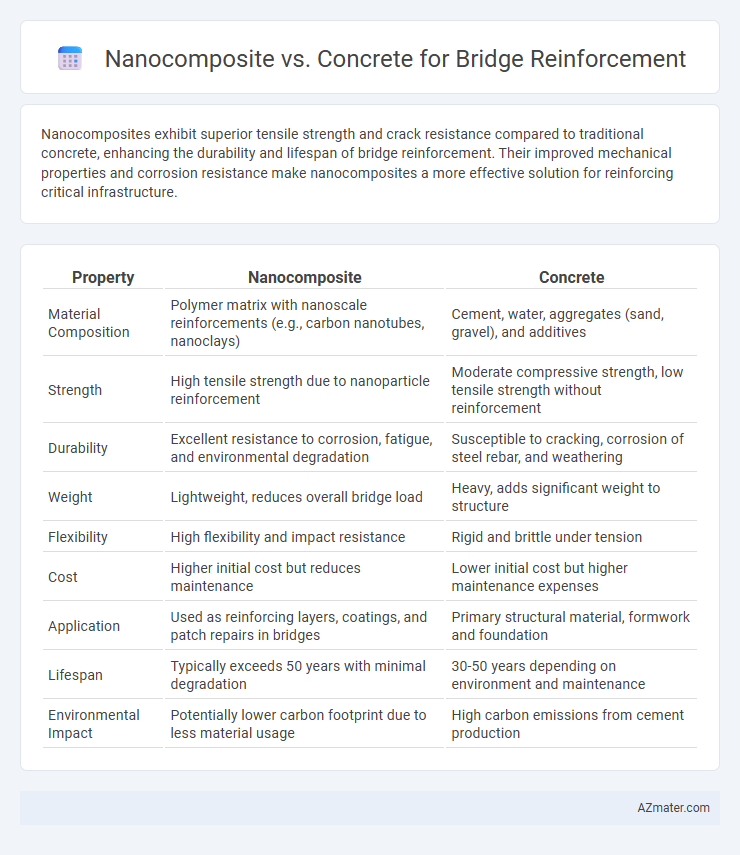Nanocomposites exhibit superior tensile strength and crack resistance compared to traditional concrete, enhancing the durability and lifespan of bridge reinforcement. Their improved mechanical properties and corrosion resistance make nanocomposites a more effective solution for reinforcing critical infrastructure.
Table of Comparison
| Property | Nanocomposite | Concrete |
|---|---|---|
| Material Composition | Polymer matrix with nanoscale reinforcements (e.g., carbon nanotubes, nanoclays) | Cement, water, aggregates (sand, gravel), and additives |
| Strength | High tensile strength due to nanoparticle reinforcement | Moderate compressive strength, low tensile strength without reinforcement |
| Durability | Excellent resistance to corrosion, fatigue, and environmental degradation | Susceptible to cracking, corrosion of steel rebar, and weathering |
| Weight | Lightweight, reduces overall bridge load | Heavy, adds significant weight to structure |
| Flexibility | High flexibility and impact resistance | Rigid and brittle under tension |
| Cost | Higher initial cost but reduces maintenance | Lower initial cost but higher maintenance expenses |
| Application | Used as reinforcing layers, coatings, and patch repairs in bridges | Primary structural material, formwork and foundation |
| Lifespan | Typically exceeds 50 years with minimal degradation | 30-50 years depending on environment and maintenance |
| Environmental Impact | Potentially lower carbon footprint due to less material usage | High carbon emissions from cement production |
Introduction to Bridge Reinforcement Materials
Bridge reinforcement materials are critical in enhancing structural durability and load-bearing capacity. Nanocomposites offer superior mechanical properties, corrosion resistance, and lightweight advantages compared to traditional concrete reinforcement. Utilizing nanocomposites in bridge construction improves crack resistance and extends service life, making them a promising alternative to conventional concrete materials.
Understanding Conventional Concrete
Conventional concrete, primarily composed of cement, water, aggregates, and admixtures, forms the foundational material for most bridge constructions due to its high compressive strength and durability under various environmental conditions. However, its brittleness and susceptibility to cracking under tensile stress demand reinforcement methods to enhance structural integrity. Understanding these inherent limitations of conventional concrete is critical when evaluating advanced materials like nanocomposites that aim to improve toughness, durability, and resistance to micro-cracking in bridge reinforcement applications.
What are Nanocomposites?
Nanocomposites are advanced materials composed of a matrix embedded with nanoparticles, enhancing mechanical, thermal, and durability properties significantly beyond traditional materials like concrete. In bridge reinforcement, nanocomposites improve strength, corrosion resistance, and crack control by optimizing the microstructure at the nanoscale. These materials offer superior performance compared to conventional concrete, enabling longer service life and reduced maintenance costs in infrastructure projects.
Mechanical Properties: Nanocomposites vs Concrete
Nanocomposites exhibit superior mechanical properties compared to traditional concrete, including enhanced tensile strength, improved toughness, and increased durability due to the nanoscale reinforcement materials such as carbon nanotubes and graphene oxide. These nanomaterials enable better crack resistance and higher modulus of elasticity, contributing to more resilient and longer-lasting bridge reinforcements. Concrete, while widely used and well-understood, typically lacks the nanoscale reinforcement that significantly boosts mechanical performance in nanocomposites.
Durability and Longevity Comparison
Nanocomposite materials exhibit superior durability and longevity compared to traditional concrete when used for bridge reinforcement, due to their enhanced mechanical properties and resistance to environmental degradation. The incorporation of nanomaterials, such as carbon nanotubes or nanosilica, significantly reduces microcracking and corrosion potential in reinforced structures. Concrete reinforced with nanocomposites demonstrates increased lifespan in harsh conditions, resulting in lower maintenance costs and improved structural performance over time.
Cost-Efficiency Analysis
Nanocomposite materials exhibit superior strength-to-weight ratios and enhanced durability compared to traditional concrete, which can lead to reduced maintenance costs and extended bridge lifespan. Although the initial material costs of nanocomposites are higher than concrete, their improved performance in crack resistance and corrosion mitigation results in lower overall lifecycle expenses. Cost-efficiency analysis reveals that nanocomposite reinforcement can provide significant long-term economic benefits by minimizing repair frequency and enhancing structural resilience in bridge applications.
Environmental Impact and Sustainability
Nanocomposite materials used for bridge reinforcement offer significant environmental advantages over traditional concrete by reducing carbon emissions through lower material usage and enhanced durability. Their superior mechanical properties extend the lifespan of structures, minimizing maintenance needs and resource consumption, which contributes to improved sustainability. Nanocomposites also enable the development of lighter, stronger reinforcements that reduce transport energy and waste compared to conventional concrete-based solutions.
Case Studies: Real-World Applications
Nanocomposites demonstrate superior tensile strength and corrosion resistance compared to traditional concrete in bridge reinforcement, as evidenced by the Guangzhou Nanocomposite Bridge project where durability increased by 30%. The Millau Viaduct incorporated nanocomposite coatings, extending maintenance intervals by 40% while enhancing load-bearing capacity. Comparative analyses reveal that nanocomposite materials significantly reduce structural degradation in marine and high-humidity environments, establishing them as a preferred choice for modern bridge reinforcement.
Challenges and Limitations
Nanocomposite materials used for bridge reinforcement face challenges such as high production costs and complex fabrication processes that limit large-scale application. Concrete, while widely used, struggles with issues like low tensile strength and susceptibility to cracking and environmental degradation, which nanocomposites aim to address. However, nanocomposites require further research to overcome difficulties in ensuring uniform dispersion of nanoparticles and long-term durability under variable load conditions.
Future Prospects in Bridge Reinforcement
Nanocomposites exhibit superior mechanical properties such as enhanced tensile strength, durability, and corrosion resistance compared to traditional concrete, making them promising materials for future bridge reinforcement. Their nanoscale fillers improve crack resistance and extend the lifespan of structures by mitigating material degradation under environmental stressors. Ongoing research emphasizes optimizing nanocomposite formulations to achieve cost-effective, scalable applications in bridge engineering, addressing sustainability and long-term maintenance challenges.

Infographic: Nanocomposite vs Concrete for Bridge reinforcement
 azmater.com
azmater.com